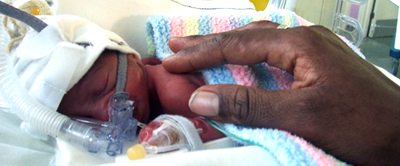|
Help with Breathing
In the womb, babies receive all oxygen from the mother via the placenta. When they are born, they have to adapt very quickly to breathing in the outside world. This can be a problem for premature babies because their lungs may not be fully developed, or they may be too weak to breathe on their own.
There are three levels of respiratory support that babies can require:
Ventilation
 At birth, babies born before 30 weeks gestation usually have a tube passed directly into their lungs to give them a drug called 'surfactant' which will make breathing easier for the baby. Surfactant is produced naturally by the body, but babies who are born early may not have enough of their own. This tube may remain in until they are strong enough to breathe on their own. Whilst this endotracheal or 'ET' tube is in place, the baby will be ventilated by a machine which pushes breaths of air into the babies lungs and effectively breathes for them . At birth, babies born before 30 weeks gestation usually have a tube passed directly into their lungs to give them a drug called 'surfactant' which will make breathing easier for the baby. Surfactant is produced naturally by the body, but babies who are born early may not have enough of their own. This tube may remain in until they are strong enough to breathe on their own. Whilst this endotracheal or 'ET' tube is in place, the baby will be ventilated by a machine which pushes breaths of air into the babies lungs and effectively breathes for them .
Older babies may need ventilation due to infection, or another problem which has made them unwell.
Continuous Positive Airway Pressure (CPAP)

Some babies require respiratory support, but do not need a ventilator. If babies are well enough to breathe on their own, they may be helped with CPAP (shown above). This consists of two short prongs (which are connected by tubes to the CPAP flow driver) which fit into the baby's nostrils and push air into the baby's lungs to help keep them inflated and make it easier for baby to breathe.
Oxygen Therapy
 Although oxygen can be given with ventilators and CPAP, some babies simply require oxygen alone. This can be given by nasal prongs (short, fine prongs into the baby's nostrils) or by using ambient oxygen (pumped into the incubator to increase environmental oxygen).
|



